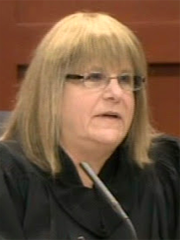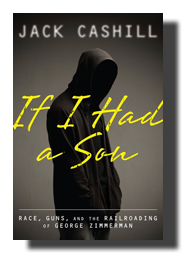George Zimmerman, Media Malpractice, and NBC
Order your copy of Jack Cashill's
"If I Had a Son"
July 2, 2014 - AmericanThinker.com
© Jack Cashill
 Life in modern America does not get more cruelly perverse than this: one major reason Judge Debra Nelson (left) threw out George Zimmerman’s libel suit against NBC on Monday was because of Zimmerman’s public pursuit of racial justice. Yes, that George Zimmerman, the same “child killer” who shot black teen Trayvon Martin in Sanford, Florida, in February 2012.
Life in modern America does not get more cruelly perverse than this: one major reason Judge Debra Nelson (left) threw out George Zimmerman’s libel suit against NBC on Monday was because of Zimmerman’s public pursuit of racial justice. Yes, that George Zimmerman, the same “child killer” who shot black teen Trayvon Martin in Sanford, Florida, in February 2012.
In the way of background, Zimmerman had sued NBC for manipulating the substance of his famous call to a police dispatcher to make him sound like a racist. In firing two employees and apologizing publicly, NBC all but admitted its guilt. What saved NBC a major payout was Nelson’s ruling that Zimmerman was a “public figure.”
According to Nelson, Zimmerman made himself a public figure by "voluntarily injecting his views into the public controversy surrounding race relations and public safety in Sanford.” He did this a year before the shooting. At the time, Zimmerman worked with the NAACP to launch a public protest over the failure of the Sanford Police Department to arrest the son of a white officer who had beaten a homeless black man
Unfortunately for Zimmerman, his work on behalf of the homeless man, Sherman Ware, was not nearly “public” enough. I could find no mention of this character-defining event in any NBC report, not even in the book NBC’s legal analyst Lisa Bloom wrote about the case, Suspicion Nation.
As NBC’s go-to source on the Zimmerman trial, a case she covered gavel-to-gavel, Bloom embodies the network ethos, and her book reflects its bias. An attorney, she has been covering murder trials for the major networks for nearly twenty years. In the way of pedigree, her mother is the notorious feminist attorney Gloria Allred.
Bloom’s thesis is that the State of Florida blew a winnable case. The evidence that the state overlooked, she writes, was “nothing short of astonishing.” Worse, the state failed to present a comprehensive “theory” about the sequence of events. This Bloom considers its “biggest blunder.”
In Bloom’s imaginative counter-theory, Zimmerman “feared” black men and profiled the seventeen year-old Martin for no reason other than his race. Only by fully ignoring the Ware case does Bloom make this claim seem remotely plausible.
As Bloom tells the story, Zimmerman follows Martin after the officer tells him not to. He confronts Martin. He “grabs or shoves him.” A “frightened” Martin punches Zimmerman. A “tussle” ensues. It is “not particularly significant” who is on top. Zimmerman pulls the gun, points it at Martin, and continues his “profane insulting rant” for forty seconds during which time Martin screams “aaah” in fear. An angry, panicky Zimmerman shoots and kills Martin.
To make this fantastic theory work, Bloom overlooks major chunks of evidence and makes stunning mistakes on the evidence she does present. Her treatment of the most important eyewitness, Witness #6, Jonathan Good, is a case in point. On the night of the shooting, Good told Sanford PD investigator Chris Serino:
So I open my door. It was a black man with a black hoodie on top of the other, either a white guy or now I found out I think it was a Hispanic guy with a red sweatshirt on the ground yelling out help! And I tried to tell them, get out of here, you know, stop or whatever, and then one guy on top in the black hoodie was pretty much just throwing down blows on the guy kind of MMA [mixed martial arts]-style.
Investigator Serino reviewed the various 9-1-1 calls the morning after the shooting. On one call, he noted, a male’s voice could be heard yelling “help” or “help me” fourteen times in roughly forty seconds. “The voice was determined to be that of George Zimmerman who was apparently yelling for help as he was being battered by Trayvon Martin,” Serino reported at the time.
Timothy Smith, the first cop on the scene, noted that Zimmerman's back was wet and covered with grass and that he was bleeding from the nose and the back of his head. He reported Zimmerman as saying, “I was yelling for help but no one would help me.” Zimmerman said this well before he knew a 9-1-1 call had picked up his screams.
Astonishingly, however, Bloom claims that all evidence “pointed to Trayvon Martin as the screamer.” To make this case Bloom ignores the testimony of Good, of Zimmerman, of Serino, and of Smith.
Of all the witnesses to testify at the trial, Good was easily the most coherent and convincing, but Bloom spends only one sentence on him and gets everything wrong. It reads as follows: “Trayvon remained a threat after the shooting, according to Zimmerman, which is why he asked John Good, the first to come outside after the gunshot, ‘to help me.’” (italics added) Of course, as both Zimmerman and Good reported, Good came out before the shooting. As Good clearly testified, Zimmerman was “yelling out help” while he was being attacked.
To make her theory work, Bloom purges other key evidence as well, including the well-documented timeline and the proven site of the attack. Martin had four minutes to run the hundred or so yards to the townhouse he was visiting. When he attacked Zimmerman, he was still seventy or so yards from that townhouse.
In the trial’s best bit of theater, defense attorney Mark O’Mara set a clock on the podium and sat in silence while four minutes counted down. Those minutes passed slowly. In four minutes, said O’Mara, some men could run a mile, but the athletic Martin was apparently unable or unwilling to run a couple hundred feet to the townhouse. More problematic, O’Mara added, was the State’s failure to explain where Martin might have gone during that time.
No viable “theory” could explain away those four minutes. Bloom doesn’t even try. She makes no mention of the four-minute gap, not even of O’Mara’s theatrics. She relies instead on the pathetically unreliable testimony of Martin’s phone friend, Rachel Jeantel, to concoct an improbable account of the confrontation at an unspecified site.
Other elements of Bloom’s theory are equally false or misleading. When the dispatcher requested that Zimmerman not follow Martin, he responded “okay” and stopped following. Just as NBC edited out Zimmerman’s “okay” in its notorious audio tract, Bloom edits out Zimmerman’s compliance. “He continues following Trayvon anyway,” she writes in full disregard of the facts.
Lest the facts interfere with her fabulation, Bloom ignores the contents of Martin’s cell phone that showed him to be an aspiring mixed martial artist with an unhealthy taste for blood. Forensic expert Richard Connor testified to this at the trial. The jury was out of the room for this proffer and so apparently was Bloom. She paints Martin as “so quiet and mild mannered that his nickname was ‘Mouse.’”
In reality, as Connor’s testimony made clear, Martin was a troubled kid. His drug use went well beyond the THC from marijuana found in his system. His cell phone exchanges showed his keen interest in getting a gun. His mother had recently kicked him out of the house for fighting. And he had been suspended from school three times in the past semester.
When Zimmerman first saw Martin, he told the dispatcher, “ This guy looks like he’s up to no good or he’s on drugs or something.” Zimmerman was likely right on both counts. Earlier that year Martin’s school had suspended him when school police found him with twelve pieces of women’s jewelry, a watch and a large flathead screwdriver described as a “burglary tool.”
Bloom protests the suspension. She attributes it to an “overly punitive ‘pushout’ cycle” that seemingly targeted African Americans even, in Martin’s case, for some innocent graffiti. What she fails to mention is that when the school police officer rifled through Martin’s book bag looking for the offending marker, he found the stolen jewelry.
Martin should have been arrested, not suspended. When the Miami Herald reported on Martin’s school record, the ensuing investigation cost the school police chief his job. At least a few officers confirmed that the chief was eager to “lower the stats” for black crime in the Miami-Dade school system. Bloom reports none of this.
Bloom’s own eureka moment came in watching the 15-minute video reenactment Zimmerman did with the Sanford police the day after the shooting. “He patted his rear end to show where the gun was,” writes Bloom of Zimmerman. She contends that in the dark there was no way that Martin could have seen the gun to reach for it, thereby proving the “falsity” of Zimmerman’s story.
Readers need not take my word for it, but should watch the video themselves. http://bit.ly/1p4ygHa It puts to rest not only Bloom’s contention about the gun, but several other major falsehoods in the book. As Zimmerman says and shows, “I had my firearm on my right side hip.” He also calmly explains how in his effort to “squirm” off the concrete, his jacket pulled up and exposed the gun.
Bloom refuses to believe that Zimmerman’s head was even on the concrete. “His statement that Trayvon was banging his head on the concrete was false. Exaggerated. A lie,” she opines bizarrely.
Bloom’s most unforgivable sin is to portray Zimmerman as an angry, mean-spirited racist. To accomplish this, she has to ignore much in addition to Zimmerman’s work with the NAACP on the Sherman Ware case. This includes the exhaustive FBI report that cleared him of the racism charge; his mentoring of two black teens; his black prom date; his black great grandfather; his Peruvian mother; his support for Barack Obama. Bloom reports none of this.
At her most Orwellian, Bloom fails to identify Zimmerman as an Hispanic, not even a “white Hispanic.” The uninitiated reader of the book would think him just another white racist in a jam. In a book all about race and victimization—“African Americans are now incarcerated at twenty-six times the level they were in 1983,” writes Bloom with a straight face--she denies Zimmerman his own heritage.
The first anniversary of the verdict is July 13. Before its on-air people, Bloom in particular, say another word about the case, NBC needs to do some serious soul searching.


